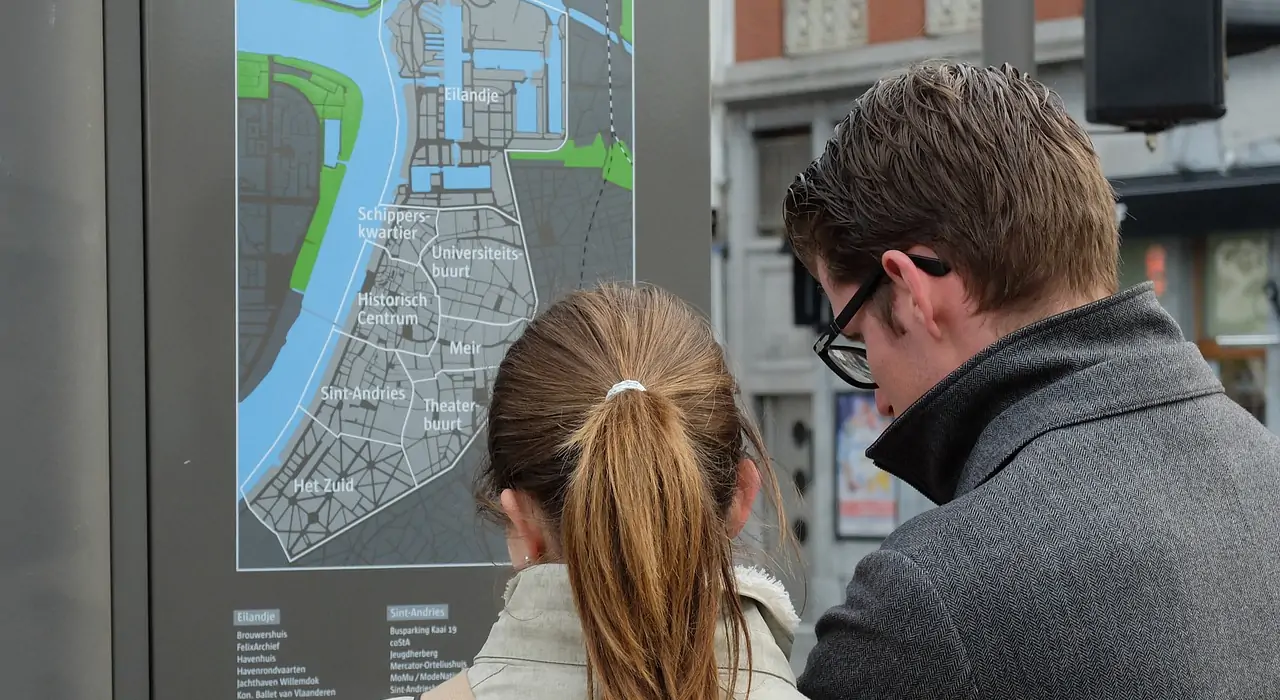Sometimes, we may need to review a map of a small district in a city that includes various landmarks and roads. To deliver a clear message about the main landmarks and their locations, we can learn from the example provided in IELTS Test 8, Section 2. Let’s dive in and learn from it.
An Example from IELTS 12 Test 8 Section 2
Here is the map of the Sheepmarket area, along with the corresponding script (original audio file) provided below:

The Sheepmarket is one of the main centres for art and history in the whole of the country. If you look at our map, you’ll see some of the main attractions there. Most visitors start (1) from Crawley Road, at the bottom of the map. The Reynolds House is one of the oldest houses in the city, and is open to the public. It’s (2) on the north side of Crawley Road, (3) next to the footpath that (4) leads to the public gardens.
The area’s particularly interesting for its unusual sculptures. (5) The Thumb’ is on Hill Road, across the road from the Bank.
The Museum’s got a particularly fine collection of New Zealand landscapes. It’s (6) on the east side of the Sheepmarket, on City Road. (7) It’s on the other side of the road from the public gardens, (8) immediately facing the junction with Hill Road.
The Contemporary Art Gallery is (9) on a little road that leads off Station Square, not far from the public gardens. (10) The road ends at the gallery – it doesn’t go anywhere else.
The Warner Gallery specialises in 19th-century art. It’s (11) on City Road, near the junction with Crawley Road, (12) on the same side of the road as the public gardens.
Finally, if you’re interested in purchasing high-quality artwork, the place to go is Nucleus. You need to go (13) from Crawley Road up through Station Square and (14) east along Hill Road until you get to a small winding road turning off. (15) Go up there and it’s on your right – if you get to City Road you’ve gone too far.
Key Collocations for Directions
| # | Collocation | Explanation |
|---|---|---|
| 1 | From Crawley Road, at the bottom of the map | Describes the starting point at the bottom of the map on Crawley Road. |
| 2 | On the north side of Crawley Road | Refers to a location situated on the northern side of Crawley Road. |
| 3 | Next to the footpath | Describes a position adjacent to a footpath. |
| 4 | Leads to the public gardens | Indicates that the footpath takes you toward the public gardens. |
| 5 | On Hill Road, across the road from the Bank | Refers to a landmark located on Hill Road, opposite the Bank. |
| 6 | On the east side of the Sheepmarket, on City Road | Describes the museum's position on City Road, east of the Sheepmarket. |
| 7 | On the other side of the road from the public gardens | Refers to something located across the street from the public gardens. |
| 8 | Immediately facing the junction with Hill Road | Indicates that the museum directly faces the Hill Road junction. |
| 9 | On a little road that leads off Station Square | Describes a road that starts at Station Square and leads elsewhere. |
| 10 | The road ends at the gallery - it doesn't go anywhere else | Indicates that the road terminates at the gallery, with no further extension. |
| 11 | On City Road, near the junction with Crawley Road | Describes the location of the Warner Gallery near the road junction. |
| 12 | On the same side of the road as the public gardens | Refers to a position on the same side as the gardens. |
| 13 | From Crawley Road up through Station Square | Indicates a path moving from Crawley Road through Station Square. |
| 14 | East along Hill Road until you get to a small winding road | Describes the route along Hill Road to a turning point at a winding road. |
| 15 | Go up there and it's on your right | Provides the final direction to locate the artwork at Nucleus on the right. |
